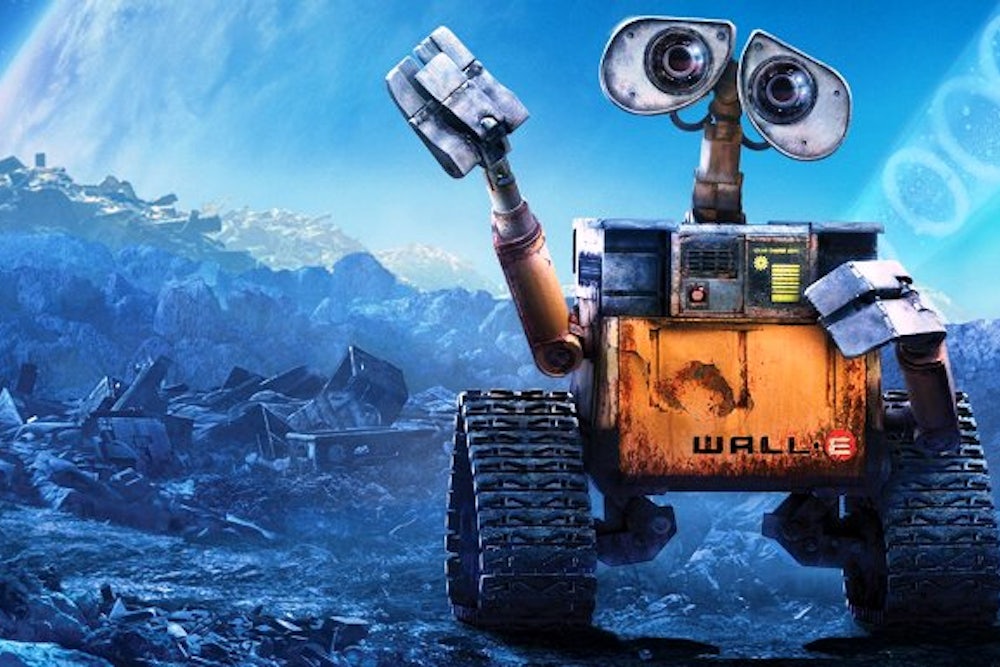For over a dozen years now, the best name in American film has been Pixar. No movie star, no director, no writer, producer, or studio approaches its level of consistent excellence. Even Pixar’s weaker offerings (A Bug’s Life, Cars, and—in my moderately heretical view—Finding Nemo) have exceptional depth and texture, moral as well as visual. And its best efforts (Toy Story, The Incredibles) are simply transcendent, rivaling the finest live-action films in sophistication and sentiment.
Pixar’s newest movie, WALL·E, is firmly in the latter tier, and quite possibly at the top of it. It is, in a word, a marvel, a film that recalls in equal measure Hollywood’s most evocative future visions—Blade Runner and Brazil, E.T. and 2001--and the silent intimacies of Buster Keaton and Charlie Chaplin. It is a story about love and loneliness, perseverance and triumph, the possibilities and pitfalls of human existence. That this story is told by way of the exploits of a tiny, faceless robot only makes it more extraordinary.
The movie, written and directed by Finding Nemo’s Andrew Stanton, opens to the strains of Hello Dolly’s “Put on Your Sunday Clothes” as the virtual camera closes in from space on an abandoned Earth, its air choked with smog and land littered with debris. (The contrast between celebratory song and dystopian vision seems a nod to Brazil, whose titular tune was also borrowed for one of the WALL·E previews.) Soon we arrive at a desolate cityscape, where empty skyscrapers jockey for position with strange, craggy spires that jut upward like outstretched fingers a thousand feet tall.
It is a profoundly creepy image, and one that becomes none the less so when we learn that these mighty summits are in fact piles of garbage, compacted into cubes and neatly stacked to the sky by an industrious little Waste Allocation Load Lifter: Earth class—a.k.a. WALL·E. The humble robot, which resembles a toaster oven on tank treads with binoculars attached on top, has been dutifully building these celestial ziggurats for hundreds of years now, and he’s been doing it alone: Human beings have long since fled the polluted planet and his fellow machines have been shut down or worn out. His professional obligations aside, WALL·E is also, like the Little Mermaid before him, an inveterate collector of human detritus: discarded silverware and lighters, a Rubik’s Cube, a battered videotape of Hello Dolly.
One day, however, his routine is dramatically interrupted by the arrival of an immense star cruiser, and on it, a robot of another sort altogether: floating effortlessly above the ground, humming softly, as smooth and white and unblemished as an egg. (It comes as no surprise that renowned Apple design guru Jonathan Ive consulted on the look.) WALL·E is smitten, though his ugly-duckling-and-the-swan courtship is complicated by this particular swan’s possession of atom blasters and a shoot-first mandate. Still, WALL·E persists, eventually introducing “EVE” (an Extraterrestrial Vegetation Evaluator) to the irresistible attractions of bubble wrap and twinkle lights. It’s clear he would travel to the ends of the Earth for her.
As it happens, he has to go much farther than that. Without spoiling the details--this is truly a film better experienced than explained--WALL·E follows EVE deep into space, where he discovers what has gone wrong with the human race and undertakes, with typical diligence, to fix it. This latter half of the film is familiar Pixar: a touch formulaic, perhaps, but executed with exceptional wit, intelligence, and panache. And while the film’s moral lessons--about the seductions of comfort and importance of effort, the proper relationship between man and machine, the need to clean up our own messes--are not unexpected, they are, like previous Pixar homilies (Toy Story 2 on commodification, Cars on commerce versus community, Ratatouille on the joy of creation), woven seamlessly into the overall fabric of the film. Neil Postman and Aldous Huxley would be proud.
Characteristically sharp as this second half is, though, it’s the earlier, Earthbound portion of the film that lingers, the quiet, nearly dialogue-free moments alone with WALL·E and the problematic object of his affections. That Pixar could make this ambulatory trash compactor so expressive, could convey his longing and loneliness so emphatically simply through the images reflected in his binocular lenses, is a cinematic miracle. You might have to go back the better part of a century to find a mainstream movie in which so much is conveyed with so very few words.
It would be easy to go on about the sheer visual beauty of WALL·E, which marks yet another milestone in the evolution of animation. Oscar-nominated cinematographer Roger Deakins (No Country for Old Men, The Assassination of Jesse James by the Coward Robert Ford) was even brought in to consult on the look of the film and offer advice on its “lighting.” But, in the end, this technical mastery is less remarkable than the humanistic ends to which it is applied.
It is an irony of Pixar’s oeuvre that its films so often feature inanimate objects (toys, cars, robots) that offer lessons in what it means to be human. But, deliberately or not, these stories appear to be refractions of a sort, retellings of the story of Pixar itself: the high-tech start-up at the cutting age of digital animation which, again and again, reminds us of the power of motion pictures—even ones about robots—that possess a vital, beating heart.
